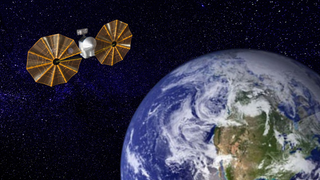
An illustration shows Lucy approaching Earth in December 2024.
(Image credit: NASA/ Robert Lea (created with Canva))
NASA’s asteroid-hopping Lucy spacecraft is on its way back to Earth for a Christmas-time rendezvous this year, before continuing its mission to investigate space rocks left over from the formation of the solar system 4.5 billion years ago.
The long journey home for Lucy began when it performed the largest blast of its main engine planned for its entire 12-year mission. The spacecraft, which launched in October 2021, fired its main engines on Saturday (Feb. 3) for more than 36 minutes. The operation followed the first blast of Lucy’s main engines on Jan. 31, which lasted for just 6 minutes.
The aim of the two engine firings, which will have exhausted over half of Lucy’s onboard fuel, is to shift the probe from its current orbit, which skims the main asteroid belt between Mars and Jupiter, into one that will bring it to the vicinity of Jupiter. That latter path will allow Lucy to become the first spacecraft to visit the Trojan asteroids, which share an orbit with the gas giant around the sun.
Related: NASA’s Lucy spacecraft successfully completes 1st flyby of asteroid ‘Dinky’
The combined maneuver altered Lucy’s velocity by around 2,000 mph (3,200 kph) and put it on course back toward Earth. Previously, the spacecraft had only fired its secondary thrusters to perform maneuvers that changed its velocity by no more than around 10 mph (16 mph).
The trajectory of Lucy, with major events indicated. (Image credit: NASA/Goddard/SwRI)
Lucy’s visit to Earth in December 2024 won’t be a social one. It will be vital in sending the spacecraft on to the Trojan asteroids, which are divided into two populations: the Greek camp, which is ahead of Jupiter in its orbit of the sun, and the Trojan camp, which trails the gas giant.
With half of Lucy’s fuel gone, the spacecraft will get a boost from Earth to help it reach these never-before-visited asteroids. This will be the second gravity assist that the spacecraft has received from Earth since its space mission began.
On Oct. 16, 2022, Lucy returned to Earth a year after its launch, coming within 220 miles (350 kilometers) of the surface of our planet. This approach, which was closer than the International Space Station flies, gave Lucy a slingshot kick while traveling at around 29,000 mph (46,700 kph).
During its second gravity assist from Earth late this year, Lucy will come within 230 miles (370 km) of the planet, getting the boost it needs to carry it through the main asteroid belt.
Lucy visited its first asteroid, the tiny main belt body Dinkinesh, or ‘Dinky,’ on Nov. 1, 2023, helping NASA scientists discover it is a double (double-double, in a way) asteroid system.
As it passes through the main asteroid belt in April 2025, Lucy will get a look at its second target, the small body 52246 Donaldjohanson.
Following this, Lucy’s next asteroid encounter will be with the Trojan family asteroid Eurybates and its satellite or ‘moonlet’ Queta in August 2027. The spacecraft will then visit four more asteroids, three of which are also double systems, allowing it to sight three more moonlets.
December 2024 will not mark the NASA spacecraft’s last visit to Earth. Lucy will get a final gravity assist from our planet in 2031, which will help it reach the large binary asteroids Patroclus and Menoetius in March 2033, which will be the final year of its prime mission.
Join our Space Forums to keep talking space on the latest missions, night sky and more! And if you have a news tip, correction or comment, let us know at: community@space.com.
Breaking space news, the latest updates on rocket launches, skywatching events and more!
Robert Lea is a science journalist in the U.K. whose articles have been published in Physics World, New Scientist, Astronomy Magazine, All About Space, Newsweek and ZME Science. He also writes about science communication for Elsevier and the European Journal of Physics. Rob holds a bachelor of science degree in physics and astronomy from the U.K.’s Open University. Follow him on Twitter @sciencef1rst.
>>> Read full article>>>
Copyright for syndicated content belongs to the linked Source : Space.com – https://www.space.com/lucy-asteroid-probe-engine-burn-return-to-earth
